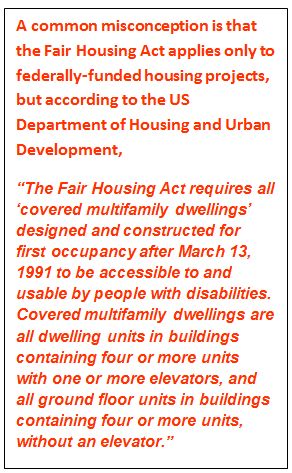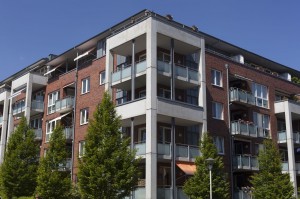This post was published in Doors & Hardware
 The Fair Housing Act was first adopted in 1968 and was amended in 1988. The law is enforced by the United States Department of Housing and Urban Development (HUD), and requires all covered multifamily dwellings ready for first occupancy after March 13, 1991 to be accessible and usable by people with disabilities. Covered multifamily dwellings include dwelling units in buildings containing four or more units if the building has an elevator, or all ground floor units if the building does not have an elevator.
The Fair Housing Act was first adopted in 1968 and was amended in 1988. The law is enforced by the United States Department of Housing and Urban Development (HUD), and requires all covered multifamily dwellings ready for first occupancy after March 13, 1991 to be accessible and usable by people with disabilities. Covered multifamily dwellings include dwelling units in buildings containing four or more units if the building has an elevator, or all ground floor units if the building does not have an elevator.
The Fair Housing Act covers many issues affecting discrimination in housing, but this article will focus on the door-related aspects of the law. There are seven basic access requirements of the Fair Housing Act:
- An accessible building entrance on an accessible route.
- Accessible common and public use areas.
- Usable doors (usable by a person in a wheelchair).
- Accessible route into and through the dwelling unit.
- Light switches, electrical outlets, thermostats and other environmental controls in accessible locations.
- Reinforced walls in bathrooms for later installation of grab bars.
- Usable kitchens and bathrooms.
There are 10 “safe harbors” or sets of guidelines which can be used to design and build multi-family housing that meets the Fair Housing Act requirements – including various editions of the International Building Code (IBC), ICC A117.1 – Accessible and Usable Buildings and Facilities, the Fair Housing Accessibility Guidelines published by HUD, and others. The requirements may vary slightly depending on which set of guidelines is used.
All residential occupancies covered by the Fair Housing Act are required to have public areas that are accessible to people with disabilities, and all dwelling units must have an accessible route into and through the unit. If a building with four or more units has no elevator, these requirements would apply only to ground floor units.
According to the HUD guidelines, accessible doors are doors in public and common use areas, as well as the public side of dwelling unit entrance doors. Accessible doors must meet the accessibility standards for doors on an accessible route, including:
- A clear opening width of at least 32 inches, measured between the face of the door open to 90 degrees and the stop on the strike jamb.
- A threshold that is limited in height and slope (refer to the design guidelines for specifics).
- The required amount of maneuvering clearance depending on the direction of approach.
- A maximum of 5 pounds of force to open an interior non-fire-rated door (8.5 pounds maximum for exterior doors if the 1986 edition of A117.1 is used, no specific limit for exterior doors if other standards are used).
- A minimum closing speed of 5 seconds for the door to move from 90 degrees to 12 degrees if equipped with a closer (doors with spring hinges are allowed to close more quickly).
- Sliding doors must provide at least 32 inches of clear width, and hardware must be exposed and usable from both sides of the door.
- Operable hardware that is “easy to grasp with one hand and does not require tight grasping, pinching, or twisting of the wrist to operate,” mounted within the allowable range – either less than 48 inches above the floor, or between 34 inches and 48 inches above the floor depending on which standard is used.
Usable doors are doors within the interior of the dwelling unit, as well as secondary exterior doors to decks, patios, or balconies. These doors are subject to less stringent requirements, but must provide at least 32 inches (nominal) clear opening width and have a low threshold or no threshold. Hardware for sliding doors should be exposed and usable from both sides of the door.
 The International Building Code reflects the Fair Housing Act requirements, by stating in Chapter 11 that some units must be Accessible or Type A units (quantity varies by occupancy type), and most of the other units must be Type B units. With regard to the dwelling unit entrance door hardware, the requirements for Accessible, Type A, and Type B units are the same – they must be operable with no tight grasping, pinching, or twisting of the wrist. The IBC references ICC A117.1 for the detailed requirements that apply to these units.
The International Building Code reflects the Fair Housing Act requirements, by stating in Chapter 11 that some units must be Accessible or Type A units (quantity varies by occupancy type), and most of the other units must be Type B units. With regard to the dwelling unit entrance door hardware, the requirements for Accessible, Type A, and Type B units are the same – they must be operable with no tight grasping, pinching, or twisting of the wrist. The IBC references ICC A117.1 for the detailed requirements that apply to these units.
According to ICC A117.1 – Accessible and Usable Buildings and Facilities (2009 and 2017 editions):
- Accessible (fully accessible) and Type A (easily adaptable) units are required to have doors and hardware that meet the requirements of Section 404, at the primary entrance door and other doors intended for user passage (refer to the standard for exceptions).
- Type B (partially adaptable) units are required to have doors and hardware that meet the requirements of section 404 on the primary entrance door. Other doors intended for user passage must have a clear opening width of at least 31 3/4 inches, and thresholds must comply with Section 303.
- Type C (visitable) units are not required to have an entrance door that meets A117.1 section 404, but ICC A117.1 requires doorways to have a clear opening width of 31 3/4 inches, minimum, and requires thresholds to comply with Section 303. However, there is no reference to Type C units in the 2021 edition of the IBC (or any prior edition), so currently most units would have to be Type B at minimum (some units would be Accessible and Type A units).
More resources on the Fair Housing Act are available at HUD.gov (search Fair Housing Act). In addition to the requirements of the referenced standards, the guidelines include many recommendations for elements that will make housing accessible and usable for all occupants, so refer to the HUD documents for detailed information.
Photo: Ralf Gosch/shutterstock.com
You need to login or register to bookmark/favorite this content.







Thanks, Lori, this is a great reference. It might be the most graphic-rich accessibility document available online, and it’s an easy read compared to the other regulations. Unfortunately they sidestepped the mechanical key issue; I think in 1998 there weren’t as many good solutions as there are today. The pictures and explanations are really good though, thanks for sharing it with the hardware world.
As I age, I am finding more and more reasons to be thankful for the ADA regulations. I am not in a wheel chair, but a reasonably healthy adult pushing 70 who recently had knee replacement surgery. Now when we travel I find myself requesting walk in showers because it’s difficult to raise my leg over the side of a tub.
My family genes passed arthritis through the generations; it is now causing me to have less strength and I find some doors to be too heavy to open. I find myself using the doors with auto operators and I try my best to use the restrooms with grab bars.
Aging is no joke. If things are this difficult for me, can you imagine the frustrations of a person in a wheel chair??!!
Lori, this is a great article. Thank you for keeping the subject current.
I hear ya, Cathy! We tend to think of the accessibility requirements in reference to someone with a permanent disability, but a huge percentage of people will have a short term disability at some point in their lives There are some sobering stats on this page: https://www.lifeinsure.com/disability-facts-and-statistics/.
– Lori